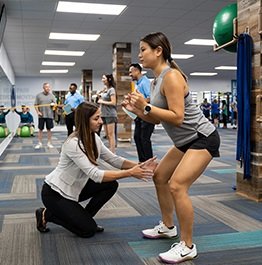
What Happens When We Foam Roll?
November 08, 2018Foam rolls are something that can be found in almost every gym, physical therapy office, chiropractic office, exercise studios, athletic training rooms, and so on. But why in recent years have they become so popular and why are we rolling around on the ground with a large piece of foam? This article will examine the research to determine what we currently understand about foam rolling and some intended uses.
Here are some reasons why people foam roll:
- Improve movement of muscles
- Decrease muscle soreness
- Lengthen tissues by breaking adhesions (tissues that are glued together)
Does scientific evidence support the above reasons?
The claims that foam rolling can improve the amount muscles move and decrease muscle soreness are backed by research!
A study published in the Journal of Strength and Conditioning found that foam rolling to the front of the thigh for a one-minute trial resulted in increased knee joint range of motion.1 The drawback of the study was that the increased range of motion did not improve overall knee joint performance. Another study looked at the effects of static stretching and foam rolling on hip flexor mobility. The study revealed that in combination, foam rolling and static stretching are more efficient than either intervention alone in improving range of motion.2 Another study concluded that foam rolling after resistance training helped to reduce onset muscle soreness (DOMS).3
The claims that foam rolling can lengthen tissues or break adhesions are not backed by evidence.
A systematic review of foam rolling was published in the International Journal of Sports Physical Therapy in 2015. There was no evidence to support foam rolling makes changes in muscle length, or that foam rolling breaks adhesions. Instead, it suggests that foam rolling is altering the resting muscle tension.
In Summary
Foam rolling can improve movement and alleviate post-workout soreness. The research does not support the idea that foam rolling can lengthen tissues or break adhesions.
References:
- Gurdogan EB, Ozdemir-ozenen D, Sandalli N. Evaluation of Surface Roughness Characteristics Using Atomic Force Microscopy and Inspection of Microhardness Following Resin Infiltration with Icon(®). J Esthet Restor Dent. 2017
- Mohr AR, Long BC, Goad CL. Effect of foam rolling and static stretching on passive hip-flexion range of motion. J Sport Rehabil. 2014;23(4):296-9.
- Pearcey GE, Bradbury-squires DJ, Kawamoto JE, Drinkwater EJ, Behm DG, Button DC. Foam rolling for delayed-onset muscle soreness and recovery of dynamic performance measures. J Athl Train. 2015;50(1):5-13.
Free Assessment
If you’re having pain while foam rolling or want to learn more about how physical therapy can help you live pain free, enter your information below for a free assessment.WANT MORE FREE PAIN-RELIEF & HEALTH TIPS?
Sign up for LIFE+ TODAY to have these practical tips sent straight to your inbox!In Chase’s free time he enjoys outdoor activities such as backpacking, surfing, and camping.
Latest posts by Chase Everwine, PT, DPT (see all)
- What Happens When We Foam Roll? - November 08, 2018
- Grilled Bananas with Mixed Berries & Vanilla Pudding Recipe - September 27, 2018
- Best Local Hike in Orange County: Deep Creek Hot Springs - August 28, 2018
- Improving Your Emotional Intelligence - May 22, 2018
- Physical Therapy After A Car Accident - February 26, 2018
- Knee Pain May Not Be Your Problem - January 22, 2018
- Choosing the Proper Shoes for Hiking and Backpacking - November 20, 2017
- How Proper Hydration Impacts Recovery - October 21, 2017
Reader Interactions
Leave a comment Cancel reply
You must be logged in to post a comment.
SIGN UP FOR
LIFE+ is a FREE membership
that offers:
• Informative Newsletters
• Health & Wellness Tips
• Videos from Our Experts
• Special offers
…and much more!
SEARCH

